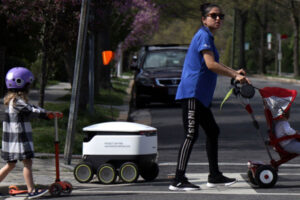By Bern Grush, Harmonize Mobility Inc., Toronto
It is expected that in some places and times service robots will be permitted to operate on public sidewalks, pathways, bicycle paths, and roadways. Will their introduction impact central business districts in our cities? Could they impact parking revenue? Will they create a need for new forms of public, shared-space monetization related to their use?
No one is surprised that we could expect some changes in the parking industry due to AVs, especially autonomous taxis for ridehailing. Ride hailing has already shown it can negatively impact parking demand.1 Surely, if the robotaxi arrives as promised — even cheaper and more reliable than ride-hailing — then parking demand would contract accordingly. But the continuous failure of promises from the autonomous passenger-vehicle industry since 2015 says this scenario is still on the far horizon — if anywhere.
Sidewalk-scaled delivery robots, also called personal delivery devices (PDDs), are far more likely to be in pervasive service in our cities and suburbs sooner than robotaxis will provide regular passenger service. This is because the multiple barriers to deployment of these sidewalk robots are more easily surmounted than the equivalent deployment barriers for the robotaxi.2
The single largest barrier to the robotaxi to date is that they are unable to go anywhere at any meaningful scale without a human in the driver seat. Hence, they cannot immediately threaten the ride-hailing industry. That barrier does not exist for the PDD, which is teleoperated at worst and increasingly merely telemonitored. Today, the leading PDD technology permits one person to concurrently operate two or three. And these can be miles apart.
What that means is that as PDD self-reliance moves from 99% to 99.99%, the ratio of robots to operator will improve from 2:1 and eventually to 10:1…




